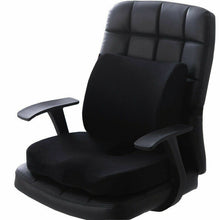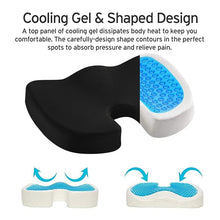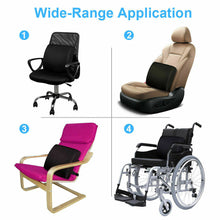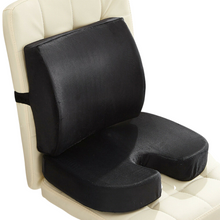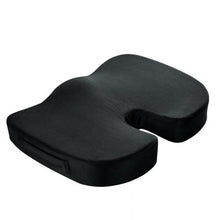
Memory Foam Seat Cushion For Back Pain

Lower back pain is among the second most common causes for people seeking help from their GP. One in six Australians suffers from back pain, which can be connected to a whole range of other symptoms, including circulation problems, bad posture, a decrease in energy levels, and conditions like sciatica.
Our back support cushions for chairs can help ease tension and relieve back, spine, and hip pain. They provide back, hip, and lumbar (lower back) support while seated. They can also act as a sciatica cushion, relieving the pain, tingling, weakness, or numbness that often radiates from the lower back down the leg.
Our memory foam back cushion can be purchased on its own or as a set with our memory foam seat cushion. Breathable and super-soft, together they allow you to sit for prolonged periods in comfort. We highly recommend purchasing both, as together they will work to provide therapeutic relief and relaxation.
These cushions are also ideal for a range of scenarios and locations. They can be used in the car, as seat cushions for the office, on conventional chairs in the living or dining room, on wheelchairs, and even on airline flights. They will transform any chair into a comfortable, ergonomic seat!
The benefits - Memory foam seat cushion
✅ Pain relief: Memory foam seat cushions conform to the shape of your body and distribute your weight evenly across the seat cushion. This helps reduce pressure points and relieves back, spine, hip pain and sciatica.
✅ Provides support: The contouring effect of memory foam cushions help support the natural curves of your back, spine and hips, providing a stable base, and reducing the need for your body to compensate by changing your posture.
✅ Decreases stress & tension: A memory foam seat and back cushion can help reduce the strain that your back, hip and spine may experience when sitting for prolonged periods.
✅ Improves posture: Sitting for prolonged periods can lead to the development of back problems. Memory foam cushions can help decrease the need to readjust how you're sitting, and straps on the back cushion will keep the cushion in place.
✅ Improves circulation: Sitting for long periods can strain your circulatory system and the blood flow moving into your back, pelvis and legs. This means your body isn't getting as much oxygen, and you may feel tired and sluggish.
✅ Supports healthy digestion: Sitting for prolonged periods can lead to constipation, bloating, abdominal cramps, diarrhoea, and even irritable bowel syndrome.
✅ Increased comfort. Sitting in an uncomfortable seat can cause stiffness and pain in your back, neck and hips. A memory foam cushion will mould to your body shape and distribute your weight across the seat to help minimise pain, especially if you're sitting for extended periods.
✅ Enhancing energy: If you're enhancing your blood circulation, you are more likely to have the energy you need throughout the day to stay focused on whatever you need to do!
Product highlights - Memory foam cushion with back
-
Material: High-quality memory foam, which is comfortable, strong, durable, and will mould to your body shape.
-
Ergonomic shape: A carefully designed shape will conform to the contours of your body.
-
Cooling panel: A top panel of cooling gel dissipates body heat to keep you even more comfortable.
-
Heat-responsive: As with all memory foam items, our seat cushions respond to heat and mould to your body for the most comfortable shape possible.
-
Mesh cover: The cover can be easily removed and is breathable, comfortable, antibacterial, and machine washable, enhancing its longevity.
-
Wide range of applications: They are recommended for the office, in the car, on conventional chairs, on flights, and on wheelchairs.
-
Lightweight and portable: These properties make it ideal for multiple scenarios, surfaces and users, including drivers, desk workers, travellers, athletes, pregnant women, and anyone who sits for long periods.
-
Cost-effective: They may decrease the need for allied health treatments, including physiotherapists and massage therapists.
Product specifications - Back support cushions for chairs
-
Colour: Black
-
Dimensions: Seat cushion: 45cm L x 35cm W x 7cm H; Back cushion: 31cm L x 32cm W x 10cm H
-
Material: High-density memory foam with a removable, washable cover.

User guide - Memory foam sitting cushion
-
Memory foam seat cushion: Place the cushion on the seat of your chair so that it feels like there is minor pressure on your tailbone and hips. Ensure that it's centred and your body is evenly supported.
-
Memory foam back cushion: If you're using the cushion for lower back support, place it against the lower back of your chair. Position it at the small of your back to encourage proper spinal alignment and reduce strain on your lower back. Make sure the cushion isn't too high or too low; it should support the natural curve of your spine to promote good posture.
Flexible use - Chair cushion for back pain
A memory foam seat cushion for back problems has a range of versatile applications, whether you use it at home, in the office, while you travel, or in a wheelchair.
If you're using it at home
-
Place it on a chair (home office, dining room, living room, media room, library) or even on the floor. It suits activities like working, reading, dining, watching TV, gentle exercise, and even meditating!
-
Make sure the seat cushion is centred on the seat you're using and the back cushion is placed against your lower back. Secure the back cushion with the straps to prevent it from moving around.
-
When you're sitting, make sure your posture is aligned. Your feet should be flat on the ground, and your knees at a 90° angle. This will support your back and hips.
-
If you feel any discomfort, adjust the cushion slightly when needed.
-
You can also use an ergonomic seat cushion to help relieve pressure points when you're napping or relaxing on a couch or in bed.
If you're using it at work
-
If you're using a seat cushion for your office chair, make sure you set up the rest of your desk space ergonomically.
-
When typing or using your mouse, ensure your feet are flat on the floor, your knees are at a 90-degree angle, and your elbows are at a similar angle.
-
Take breaks and adjust the cushion/s if needed—sitting for long periods can still cause discomfort—even with memory foam cushions.
-
Stand up, stretch and walk around every 30 to 60 minutes.
If you're using it for travel
-
A seat cushion for back problems can be used when travelling in a car, by bus, or on a plane.
-
If you're in a car, centre the cushion so that it supports your hips, thighs, and tailbone. Adjust it for comfort when needed, and ensure your spine stays aligned and your knees are at a 90° angle if possible.
-
If you're travelling by plane or on a bus, an orthopaedic seat cushion can help reduce pressure on your thighs and buttocks during long periods of sitting. Place it against the small of your back to encourage proper posture and help alleviate any back pain. You can use it under your knees (in a reclined position, such as on a plane) to elevate your legs, improve circulation, and reduce pressure on your legs and lower back. You can also use it while waiting at bus stations or airports as it will provide extra support when sitting on hard seats or benches.
If you're using it in a wheelchair
-
If using a memory foam chair cushion, ensure it is correctly centered on the wheelchair seat so that it provides support across the entire seating area.
-
Aligning it with the seat base will minimise the chances of it shifting or slipping when the user is in motion.
-
Adjust it for posture and comfort—when seated, the hips should be aligned with the knees at a 90-degree angle.
-
Because it is made from memory foam, it can also be used to relieve pressure points as it will distribute weight more evenly and reduce the risk of pressure sores developing.
-
Users should shift their position regularly—every 15 to 30 minutes, depending on comfort and mobility.
FAQs | Memory foam seat cushion
-
1. What should I consider when choosing a memory foam seat cushion?
Finding the right memory foam seat cushion to suit your needs can make a world of difference to your posture and comfort. It should provide firm support, evenly distribute your weight, promote natural spine alignment, reduce strain on your hips and lower back, and ultimately, provide pain relief, including conditions such as sciatica. It should also offer benefits that align with how, why, and when you intend to use it.
-
2. How does a sciatica cushion help with sciatic nerve pain?
Sciatica is pain caused by the irritation or compression of the sciatic nerve (the longest nerve in the body) and typically starts in the lower back and extends down the leg and sometimes to the buttocks and feet. If you suffer from sciatica, you will probably be familiar with the discomfort it causes, which can be exacerbated if you sit for long periods. A memory foam cushion for sciatica pain can help relieve discomfort by improving your posture and reducing pressure on the sciatic nerve. It can help keep your spine correctly aligned and evenly distribute your weight, which can improve circulation, reduce tingling and numbness, and allow you to sit more comfortably for extended periods.
-
3. What does the cooling gel panel do on a memory foam seat cushion?
Cooling gel panels absorb and disperse heat, minimising overheating and providing a cooler seating experience.
-
4. Can people of all ages use a memory foam seat cushion?
Yes, but the level of comfort and support can vary depending on the individual's needs. They are beneficial for adults who sit for extended periods, and with older adults, they can enhance comfort, improve circulation, and minimise pressure sores.







